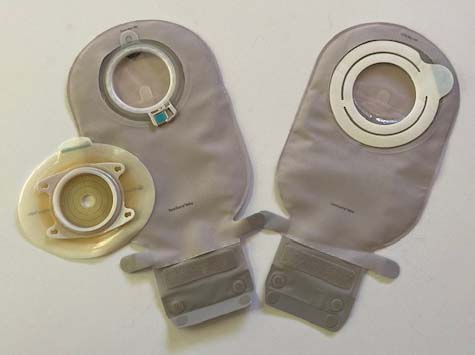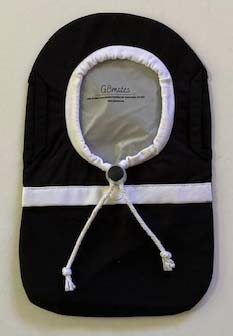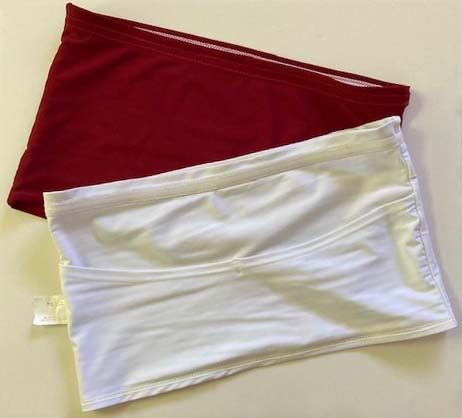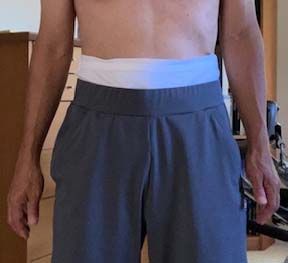It’s 329 days ATN and 20 days into Life With an Ostomy.
It’s also my 21st birthday! (That’s 21b26. At some point you just start adjusting the base. For those of you not so mathematically inclined the Earth loops around the sun roughly 53 times in that time.) Many years ago I couldn’t imagine being 53 (or 50 or 40 or 21b10). And I suppose I’m at 53 thanks to averting that cancer bullet, so it’s time to celebrate…with lots of birthday coupons! The day started with a venti skinny mocha compliments of Starbucks. Lunch might be a char burger from The Habit. And sometime this month I’ll need to pick up a box of original glazed from Krispy Kreme. Aren’t birthdays great?!
This post focuses on the ostomy, “poop management”, and all the accessories available for ostomates. All that stuff you eat (even on your birthday) needs to make its way out. Some of you may want to skip ahead, but for those of you who are curious (or maybe starting out with an ostomy yourself…)
Everybody Poops – But Not In The Same Way (Life With an Ostomy)
Ok as promised in the previous post here’s one on Life With an Ostomy. If you’re not sure what an ostomy is there’s a somewhat light-hearted description here.
What I currently have is a (temporary) ileostomy while my rectum heals after being subjected to a lower anterior resection. Which means I’ll become an expert in how to deal with an ostomy just in time to not need to know about it (and I assure you, I’m finding every way an ostomy pouch can fail!).
In an ileostomy the end of the small intestine is brought out to your abdomen. The part where it’s brought out is called a stoma, and it’s your new butt hole. Sort of. The stoma doesn’t have a sphincter so you really have no control over when things pass through it. So its not like you can find a toilet (and lean over it?) to poop. Since things go when they go, you generally use a pouch to catch everything.
And let me tell you – there’s a whole cottage industry around ostomy pouches and another industry around accessories for the pouch. Finding the right pouch (and accessories) can really improve your lifestyle!
(I’m going to focus on life with a pouch rather than how-to-put-on-a-pouch. Hopefully they taught you that at the hospital or, like me, you’ve got a home healthcare nurse to help you out.)
Lessons & Tips
Before getting into the pouches and accessories, here are a few things that my surgeon failed to mention but that are Really Important.
- If you have carpet in your bedroom or bath, have it replaced with hardwood flooring prior to your ostomy. It’s much easier to clean up!
- If you failed to heed #1 (or found this blog a little too late), then get a good spot steam cleaner. Like the Hoover Spotless Portable Cleaner.
- Buy lots of rugs. It’s easy to throw them in the washing machine.
- Get a waterproof or water resistant mattress cover like the SafeRest Mattress Protector.
- Think you don’t need toilet paper? Think again! You’ll just be wiping something different. (That said your ostomy pouch probably doesn’t care if you use Charmin Ultra Soft or some cheap-o TP.)
- If you have pouches where you trim the opening to match your stoma size, buy curved surgical scissors which have a blunt tip. I got the Metzenbaum 6″ curved surgical scissors from Amazon. DO NOT use scissors with a sharp tip or you might puncture the pouch. You will of course discover the puncture in the most unfortunate way.
Think that’s a bit overkill? Well…
- You will fumble while opening a drainable pouch. Hopefully you’re doing this over a toilet. Even then be wary of splashes…
- If you’re using a drainable pouch the drain will spontaneously open. (OK this is not supposed to happen. Ever. Just like the chemo line from your pump is never supposed to get cut. But trust me, it does happen.)
- If you’re using a two-piece pouch you will at some point accidentally pull the pouch off while venting or taking a shower (the latter isn’t too bad. Just make sure everything’s cleaned up before you set foot out of the shower.)
- The pouch will leak. Actually this is the most common reason for “accidents” but since I appear to be in the advanced pouch failure course I have yet to experience it. I’m sure it’ll happen in due time. See pouch covers below for mitigating this.
Now on to the less important stuff…
Pouches
The pouch is essentially your new rectum where waste goes until you’re ready to dispose of it. So finding the right pouch is all-important.
There are one piece pouches and two pieces pouches, “drainable” and single-use pouches, low profile pouches, high-volume pouches, pouches with filters, pouches with convex bases, etc.

At the hospital they used the Coloplasty one-piece drainable pouch with filter. One piece means that you affix the pouch directly to your abdomen. Two-piece pouches have a base which goes on your abdomen, and then the pouch attaches to the base. More on the two piece version in a moment. Drainable means that the bottom of the pouch has an opening so you can open up the pouch and empty the contents into a toilet. Think of it as your manual sphincter.
The filter is at the top of the pouch and lets gas out. Everything goes into the pouch, including gas, which can make the pouch swell like a balloon. If the pouch has a filter then (in theory) the gas is slowly let out. There’s some carbon in the filter to make the gas rather less aromatic. I say “in theory” since once the filter gets wet nothing passes through it. And trust me if you have an ileostomy the filter will get wet in the first day or two. Often in the first day or at latest the first night. The reason is that the output of an ileostomy can be rather liquidy. The colon is where water is extracted from poop and the ileostomy diverts things before the colon. If you’re standing up all that slushy or liquidy poop will go to the bottom of the bag. No problem. But unless you sleep standing up that won’t be the case when you get some shut eye. And then the filter will clog. This is a very common issue and from various message boards and blogs it seems a lot of people see the filter as a waste of money. Unless you’re using disposable (non-drainable) pouches when you’ll be replacing at least once a day, just get the cheaper pouches without filters.
(If you’re a true old-school vampire who sleeps hanging upside down I recommend putting your pouch on upside-down as well before hanging yourself up. But really, upgrade to a coffin. Or even a memory foam bed – way more comfortable!)
So if you have a pouch without a filter, what do you do when the pouch fills up with gas? Well if you have a one-piece drainable pouch you drain the pouch. Always, always, always do this over a toilet even if you’re only letting gas out! You never know when the pouch might slip out of your hands as you undo the opening. Or a bit of something other than gas may decide to slip out. Things will be very messy then!
Things are much easier with a two-piece system. You can crack open the seal between the pouch and base just a little to let the gas escape. If you’re smart you’ll let things out from the top – there’s little chance anything else will try to make a bid for freedom then. (Of course be careful to open it up just enough so gas gets out. Not so much that the pouch is at risk of coming off the base, or you’ll have another mess on your hands.) Whether you’re using a drainable or disposable two-piece this is a good way to deal with gas. If you’re out and about you can just find a private area and let it out. (Tip: This is particularly easy with the two-piece Hollister pouch since the rim on the pouch side is flexible. Just bend it a little away from the base and you’ve got a tiny opening to let the gas out. The Coloplasty two-piece has a more rigid seal making it more difficult to create a small opening without a good part of the pouch ring detaching. The Coloplasty generally does secure the pouch to the base better, though, especially the ones with the “click” system. I guess it depends what’s more important to you).
The other upside of a two-piece system is that it’s easier to install. Basically to attach a pouch, you first put a sticky foam ring around the stoma. This serves as a barrier – you Do Not Want any poop getting in contact with the skin of your abdomen. You’ll get a rash, or worse if there’s prolonged contact. In a two-piece you put the base on top of the ring. Since you can see through the ring it’s easy to see how things are positioned. If you’re using a one-piece (especially an opaque one-piece) then its a bit harder to tell if you’ve got the pouch opening centered properly.
The downside of a two-piece is that it’s a bit higher profile. Personally I don’t think it’s a big problem – and the base keeps things from compressing the stoma (why is it stomas are always at waist band level?). But if for some reason you’re going for a trim look then a one-piece might be better for the occasion. Coloplasty also has a non-detachable two-piece where you put on a base first them attach the pouch, but the pouch is attached with a strong adhesive so can’t be removed. Since there’s no attachable rubber ring it’s as low profile as one-piece pouches but with the easy of installation of a two piece.
There are yet more options: curved bases if your stoma is at or below skim level, flexible bases which may be more comfortable if you’re exercising or the stoma isn’t at a mostly flat area, and “high volume” pouches if you want to go a while without changing/draining the pouch (i.e. you want a good night’s sleep – or are just experiencing a “high output” situation :-))
Different pouches may be best for different situations. I generally prefer the Hollister two-piece drainable pouch. I can let gas out easily and empty the pouch into a toilet when it gets full. But I might switch to disposable pouches (same two-piece system) on a road trip so I don’t need to find a toilet. Just throw the pouch away and snap on a new one.
Accessories
Finding the right pouch system goes a long way to improving life, but there are a few accessories that help even more. There are a few issues the accessories address. Pouches can leak. Hopefully you don’t experience this often but when it does happen you want to contain things. Pouches can also get heavy as they fill, especially if you have an ileostomy where things have a higher water content. And lastly you may just want to hide the ostomy pouch. Even if you have it in your pants or shorts, the top of the pouch is almost sure to be above waist line. If you’re wearing a t-shirt and reach up then your abdomen – and pouch – will then be exposed. I don’t care about that too much – I wear larger shirts to begin with so its unlikely things will show no matter how I contort my body – but others might be more self-conscious.

Ostomy pouch covers. These are exactly what they sound like – a cover for the pouch. The primary purpose is to conceal the pouch. You can get them in all sorts of colors or printed with patterns and even logos. There are also covers with a water-resistant interior lining, so if the pouch leaks everything will be contained. I got a GBmates pouch cover after an unfortunate instance where the pouch spontaneously opened (as I said, it does happen! Fortunately Amazon delivered this the next day. Unfortunately they’re taking longer to deliver the carpet spot cleaner…)
Ostomy belts. Belts help to support the pouch, just as regular belts hold up your pants. Most of them look like hernia belts, with an added opening around the stoma. The pouch itself usually hangs outside the belt but the base is under the belt and held securely. I don’t have personal experience with a belt so can’t say how well they work or when you might prefer one vs the other accessories.
Ostomy wraps. Wraps are basically sashes made of an elastic material you slip on your waist. Like belts, many wraps seem to be designed so that they support the base of the pouch while the pouch itself hangs outside the wrap. Since the wrap is stretchable material it can be more comfortable than a belt. If you want to hide the pouch you’ll want to use the wrap in conjunction with a cover. the second type of wrap is one which goes over the pouch. The entire pouch is held against your body providing support, but since the material is stretchable it won’t impeded the stoma or pouch from filling. The wrap may also have an inner pocket. This adds further support for the pouch and, while not quite as good as a cover, will help to catch any leaks.


Fortunately before buying any of the more expensive wraps I came across the Awestomy ostemy wrap. There are many good reviews and testimonials on the web such as this one. At $20 a piece it’s affordable (a key consideration even when your ostomy isn’t temporary!) and comfortable. And it provides good support for the pouch without impeding its function. The pocket should also prevent the pouch from, ahem, opening at unexpected times and will also hopefully help to contain any leaks. Highly recommended!
I also have a GBates ostomy bag cover. I find the Awestomy wrap more comfortable (even as the pouch fills it doesn’t pull down on the base), but there are times like while sleeping I’m more concerned about leaks than general support. And the bag cover is great for that.
That’s it for now. I’m sure there will be a follow-up Adventures in Waste Management post. And yes I have been bean-counting the journey and I’ll get around to a post on that at some point. A preview: The hospital charged $118k for the pleasure of my company. Anthem (who thinks it knows exactly how much my company is worth) paid $25k. This is the “negotiated rate” which applies to my (grandfathered) Anthem insurance plan so I pay $0 (my deductible was met several months ago…). There’s something crazy going on here, but I think Anthem just saved me close to $100k, or just about all the plan premiums I’ve paid in the last 15 years I’ve had it!
